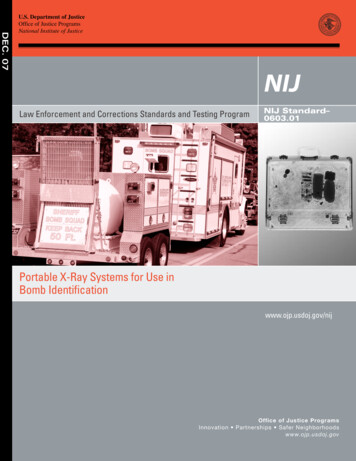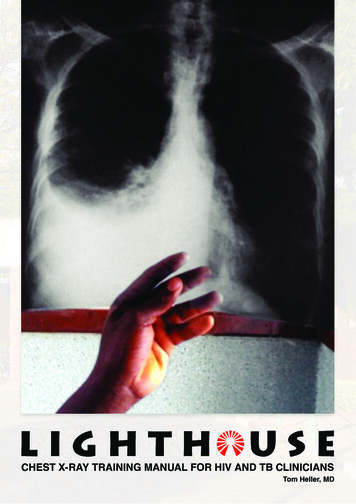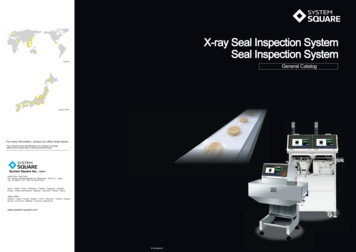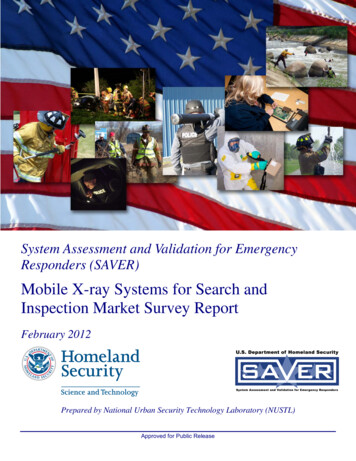
Transcription
DEC. 07U.S. Department of JusticeOffice of Justice ProgramsNational Institute of JusticeLaw Enforcement and Corrections Standards and Testing ProgramNIJ Standard–0603.01Portable X-Ray Systems for Use inBomb Identificationwww.ojp.usdoj.gov/nijOffice of Justice ProgramsInnovation Partnerships Safer Neighborhoodswww.ojp.usdoj.gov
U.S. Department of JusticeOffice of Justice Programs810 Seventh Street N.W.Washington, DC 20531Michael B. MukaseyAttorney GeneralCybele K. DaleyActing Assistant Attorney GeneralDavid W. HagyActing Principal Deputy Director, National Institute of JusticeThis and other publications and products of the National Instituteof Justice can be found at:National Institute of Justicewww.ojp.usdoj.gov/nijOffice of Justice ProgramsInnovation Partnerships Safer Neighborhoodswww.ojp.usdoj.gov
U.S. Department of JusticeOffice of Justice ProgramsNational Institute of JusticePortable X-Ray Systems for Use in Bomb IdentificationNIJ Standard–0603.01Supersedes NILECJ–STD–0603.00, X-Ray Systems for Bomb Disarmament, dated June 1975Coordination by:Office of Law Enforcement StandardsNational Institute of Standards and TechnologyGaithersburg, MD 20899–8102Prepared for:National Institute of JusticeOffice of Science and TechnologyWashington, DC 20531December 2007NCJ 218586
National Institute of JusticeDavid W. HagyActing Principal Deputy DirectorThis standard was prepared for the National Institute of Justice, U.S. Department of Justice, by the Officeof Law Enforcement Standards (OLES) of the National Institute of Standards and Technology (NIST)under Interagency Agreement Number IA2003–IJ–R–029, Project No. 06–001.This standard was developed under the direction of Nicholas Paulter, Program Manager for Detection,Inspection, and Enforcement Technologies, and Kathleen M. Higgins, Director of OLES.
FOREWORDThe Office of Law Enforcement Standards (OLES) of the National Institute of Standards and Technology(NIST) furnishes technical support to the National Institute of Justice (NIJ) program to support lawenforcement and criminal justice in the United States. OLES’s function is to develop standards and conductresearch that will assist law enforcement and criminal justice agencies.OLES is: (1) subjecting existing equipment to laboratory testing and evaluation, and (2) conducting researchleading to the development of several series of documents, including national standards, user guides, andtechnical reports.This document covers research conducted by OLES in collaboration with the Police Scientific DevelopmentBranch in the United Kingdom under the sponsorship of NIJ. Additional reports as well as other documentsare being issued under the OLES program in the areas of protective clothing and equipment, communicationssystems, emergency equipment, investigative aids, security systems, vehicles, weapons, and analyticaltechniques and standard reference materials used by the forensic community.Technical comments and suggestions concerning this guide are invited from all interested parties. They maybe addressed to the Office of Law Enforcement Standards, National Institute of Standards and Technology,100 Bureau Drive, Stop 8102, Gaithersburg, MD 20899 8102.David W. HagyActing Principal Deputy Director,National Institute of Justiceiii
CONTENTSPageFOREWORD . iiiCOMMONLY USED SYMBOLS AND ABBREVIATIONS.vI.INTRODUCTION .11.1 Purpose and Scope .11.2 Classification .11.3 Definitions .12. REQUIREMENTS.32.1 Minimum Performance Specifications .32.2 System Requirements.42.3 Operating Requirements .72.4 Support Requirements.83. TEST METHODS.103.1 Minimum Performance Specifications .103.2 System Requirements.123.3 Operating Requirements .143.4 Support Requirements.153.5 Standard Test Conditions.163.6 Test Equipment .163.7 Test Patterns.174. REFERENCES .19FIGURESFigure 1.Figure 2.Figure 3.Figure 4.Setup for Image Quality Test .11Positioning of Radiation Monitor for Leakage Radiation Test .13Plan View of the Portable X-Ray Test Pattern.17The Components of the Portable X-Ray Test Pattern .18iv
COMMONLY USED SYMBOLS AND ABBREVIATIONSAacAMcdcmCPc/sDdBdc C FdiaemfeqFfcfig.FMftft/sgggramperealternating currentamplitude modulationcandelacentimeterchemically purecycle per seconddaydecibeldirect currentdegree Celsiusdegree Fahrenheitdiameterelectromotive forceequationfaradfootcandlefigurefrequency modulationfootfoot per bf inlmlnlogMmminmmmphm/smSvNN mhenryhourhigh frequencyhertzinside rcepound-force inchlumenlogarithm (base e)logarithm (base 10)molarmeterminutemillimetermile per hourmeter per secondmillisievertnewtonnewton hfUVVvhfWλwtnanometernumberoutside diameterohmpagepascalprobable errorpagesparts per millionquartradianradio frequencyrelative humiditysecondstandard deviationsectionsievertstanding wave ratioultrahigh frequencyultravioletvoltvery high frequencywattwavelengthweightarea unit2 (e.g., ft2, in2, etc.); volume unit3 (e.g., ft3, m3, etc.)PREFIXESCOMMON CONVERSIONS(See ASTM E380)dcmµnpdeci (10-1)centi (10-2)milli (10-3)micro (10-6)nano (10-9)pico (10-12)dahkMGTdeka (10)hecto (102)kilo (103)mega (106)giga (109)tera (1012)0.30480 m 1 ft25.4 mm 1 in0.4535924 kg 1 lb0.06479891 g 1 gr0.9463529 L 1 qt3600000 J 1 kW hr4.448222 N 1 lbf1.355818 J 1 ft lbf0.1129848 N m 1 lbf in14.59390 N/m 1 lbf/ft6894.757 Pa 1 lbf/in21.609344 km/h 1 mphTemperature: T C (T F-32) 5/9Temperature: T F (T C 9/5) 32v
NIJ Standard–0603.01NIJ STANDARD FOR PORTABLE X-RAY SYSTEMSFOR USE IN BOMB IDENTIFICATION1. INTRODUCTION1.1 Purpose and ScopeThe purpose of this standard is to establish performance requirements and testing methods forportable x-ray systems for use in bomb disarming operations. This standard does not apply tocabinet x-ray systems, such as those used for security screening.1.2 Classification1.2.1 Type I. Battery Powered Portable X-Ray SystemsA portable x-ray system entirely powered by low-voltage batteries.1.2.2 Type II. Optional Powered Portable X-Ray SystemsPortable x-ray systems for which the operator can select either low-voltage battery or AC-mainspowered operation.1.3 DefinitionsComprises all the component units used in the production, capture, display, and storage of an xray image. All defined terms are presented in italics within this document.1.3.1 AnodeThe positive electrode/terminal of an electrical device. In x-ray tubes, the anode is typicallymade of tungsten and produces x-rays when bombarded by high energy electrons.1.3.2 ApertureThe surface on the x-ray generator module from which the useful x-ray beam exits and which isin a plane normal to the beam direction.1.3.3 Control and Display UnitThe component of the portable x-ray system that enables the operator to activate and control xray generation and display the images obtained with the image capture unit. Typical methodscurrently used for image display include instant-print film, cathode-ray tubes, and flat paneldisplays.1
1.3.4 ExposureFor radiation protection purposes, exposure to ionizing radiation is measured as dose equivalent.This is defined as the amount of any type of radiation that, when absorbed in a biological system,results in the same biological effect as one unit of absorbed dose delivered in the form of lowlinear-energy transfer radiation. The unit of dose equivalent is the sievert (Sv).1.3.5 Field of ViewThe horizontal and vertical extent of the target plane that is to be imaged.1.3.6 Image Acquisition PeriodThe interval required to capture (or expose) the image and then to display (or process) the image.The image acquisition period does not include the time required to retrieve the film from theimage capture unit and then convey the film to the control and display unit.1.3.7 Image Capture UnitThe component of the portable x-ray system that is used to acquire the x-ray image. Typicalmethods currently used include film and solid-state digital imaging arrays.1.3.8 Portable X-Ray SystemA man-portable self-contained x-ray system used to acquire images for bomb diagnostics andrender safe procedures. The portable x-ray system comprises the x-ray generator module, theimage capture unit, and the control and display unit.1.3.9 Radiation, IonizingAny electromagnetic or particulate radiation capable of producing ions, directly or indirectly, byinteraction with matter.1.3.10 Radiation, LeakageAll ionizing radiation, except the useful beam, coming from an x-ray generator module.1.3.11 Radiation, PrimaryIonizing radiation coming directly from an x-ray tube anode and passing through the aperture.1.3.12 Radiation, ScatteredIonizing radiation that, during passage through matter, has been deviated in direction and usuallyhas had its energy diminished.1.3.13 TargetAn object that is imaged by the portable x-ray system. The target can also be a test pattern.2
1.3.14 Target PlaneThe plane (imaginary flat surface) extending vertically and horizontally from the center of thetarget. The target plane is perpendicular to the direction of the x-ray beam.1.3.15 Useful X-Ray BeamThat part of the primary and scattered radiation, which passes through an aperture, cone, orother collimating device.1.3.16 X-Ray Generator ModuleThat part of a portable x-ray system comprising the x-ray tube, shielding material, anypermanently attached devices (collimators) used to restrict the field of the useful x-ray beam, andthe high-voltage power supply. The x-ray tube is often a field-replaceable component.1.3.17 X-Ray Output PowerThe power output of the x-ray generator module, expressed as either the number of pulses for apulsed x-ray generator or the combined values of kV and mA for a continuous-wave x-raygenerator.2. REQUIREMENTS2.1 Minimum Performance SpecificationsThe specifications listed in this section are those directly relating to the function of the portablex-ray system, which is to provide x-ray images.2.1.1 Image QualityThe portable x-ray system shall be able to fully resolve the copper resolution grids (see figure 3,lower left corner and upper right corner, pattern containing copper wires) and be capable ofpermitting all of the 33 AWG tungsten wires of the test pattern behind 10 mm (0.4 in) of steel tobe seen. The lead corner pieces of the test pattern shall also be clearly visible when tested inaccordance with the image quality test of section 3.1.1.2.1.2 Field of ViewThe x-ray generator module of the portable x-ray system shall be capable of providing anexposure area of at least 39.1 cm vertical by 39.1 cm horizontal (15.4 in vertical x 15.4 inhorizontal) at a source-to-target distance of 59 cm 5 cm (24 in 2 in), and the exposure areashall meet the requirements of section 2.1.1 as tested per section 3.1.1.2.1.3 Image Acquisition PeriodThe image acquisition period shall not exceed 240 s.3
2.1.4 Image ExtentThe image capture unit shall be capable of providing image information to within 12 mm or lessof the surface on which it is placed with no degradation of image quality, as defined in section2.1.1, over the entire surface of the image.2.2 System RequirementsThe requirements listed in this section affect the functional performance or use of the instrument.2.2.1 Safety2.2.1.1 Leakage RadiationThe average exposure of leakage radiation from the x-ray generator shall not exceed 1 mSv inany 1 h period of operation, when measured in accordance with the leakage radiation test ofsection 3.2.1.1.2.2.1.2 Electrical SafetyThe portable x-ray system shall meet the applicable requirements of UL 61010A–1, as amended;and/or IEC 61010–1, as amended, IEC 60601–2–7, as amended, and IEC 60601–2–28, asamended.2.2.2 Electromagnetic CompatibilityThe equipment shall meet the applicable requirements for susceptibility to interference fromelectromagnetic radiation and for emission of electromagnetic interference.2.2.2.1 Emissions2.2.2.1.1 Radiated EmissionThe portable x-ray system, when adjusted to meet the requirements of section 2.1, shall meet therequirements of 47 CFR Part 18, as amended, and/or CISPR 11, as amended.2.2.2.2 SusceptibilityThe x-ray generator module is not subject to the requirements of susceptibility.2.2.2.2.1 Radiated Susceptibility, Electrostatic DischargeThe portable x-ray system, when adjusted to meet the requirements of section 2.1, shall notmalfunction when tested in accordance with IEC 61000–4–2, as amended, and using the testspecifications given in IEC 61000–6–1, as amended, for contact discharge.4
2.2.2.2.2 Radiated Susceptibility, RF EmissionsThe portable x-ray system, when adjusted to meet the requirements of section 2.1, shall notmalfunction when tested in accordance with IEC 61000–4–3, as amended, and using the testspecifications given in IEC 61000–6–1, as amended.2.2.2.2.3 Radiated Susceptibility, Electrical Fast Transient/BurstThe portable x-ray system, when adjusted to meet the requirements of section 2.1, shall notmalfunction when tested in accordance with IEC 61000–4–4, as amended, and using the testspecifications given in IEC 61000–6–1, as amended2.2.2.2.4 Conducted Susceptibility, Radio Frequency Common ModeIf applicable, the portable x-ray system, when adjusted to meet the requirements of section 2.1,shall not malfunction when tested in accordance with IEC 61000–4–6, as amended, and using thetest specifications given in IEC 61000–6–1, as amended.2.2.2.2.5 Conducted Susceptibility, SurgesIf applicable, the portable x-ray system, when adjusted to meet the requirements of section 2.1,shall not malfunction when tested in accordance with IEC 61000–4–5, as amended, and using thetest specifications given in IEC 61000–6–1, as amended.2.2.2.2.6 Conducted Susceptibility, Power Frequency Common ModeIf applicable, the portable x-ray system, when adjusted to meet the requirements of section 2.1,shall not malfunction when tested in accordance with IEC 61000–4–8, as amended, and using thetest specifications given in IEC 61000–6–1, as amended.2.2.2.2.7 Conducted Susceptibility, Voltage Dips and InterruptionsIf applicable, the portable x-ray system, when adjusted to meet the requirements of section 2.1,shall not malfunction when tested in accordance with IEC 61000–4–11, as amended, and usingthe test specifications given in IEC 61000–6–1, as amended.2.2.3 PowerBattery-powered portable x-ray systems shall meet the image quality requirement of section2.1.1 when tested in accordance with the image quality test of section 3.1.1.All batteries used in the portable x-ray system shall be of a type that are easily replaced orrecharged.5
2.2.4 Ruggedness2.2.4.1 BumpThe portable x-ray system shall meet the leakage radiation requirement of section 2.2.1.1 and theimage quality requirements of section 2.1.1 after being tested in accordance with therequirements of IEC 60068–2–29, 1987, as amended, using 100 bumps applied to each of the sixsides (top, bottom, left, right, front, and back) of each component of the portable x-ray systemwith each bump having a nominal peak acceleration of 15 g (150 m/s2) and a nominal pulseduration of 6 ms.2.2.4.2 DropThe portable x-ray system shall meet the leakage radiation requirement of section 2.2.1.1 and theimage quality requirements of section 2.1.1 after each component (x-ray generator module,image capture unit, and control and display unit), properly contained within its transport case,has been tested in accordance with the requirements of IEC 68–2–32 Procedure 1, 1975, for eachface and corner of the component when contained within its transport case and a fall height of0.3 m 0.03 m.2.2.5 Environmental Requirements2.2.5.1 Temperature Stability and RangeThe portable x-ray system shall operate over the ambient temperature range of at least -18 C to43.5 C (0 F to 110 F). The portable x-ray system shall be tested in accordance with MIL–STD–810F Method 501.4, as amended, Procedure II, at 43.5 C 3 C (110 F 5.4 F) afterbeing exposed to that temperature continuously for 24 h 1 h. The portable x-ray system thenshall be cooled to -18 C 3 C (0 F 5.4 F) within 4 h 0.5 h and tested in accordance withMIL–STD–810F Method 502.4, as amended, Procedure II, at -18 C 3 C (0 F 5.4 F) afterbeing exposed to that temperature continuously for 24 h 1 h.2.2.5.2 Relative Humidity Stability and RangeThe detector shall be tested in accordance with the requirements of MIL–STD–810F Method507.4, Procedure III, 10 cycles, as amended.2.2.5.3 Environmental ProtectionThe portable x-ray system shall meet or exceed the requirements for compliance with IEC60529, as amended, classification IP54.The portable x-ray system shall meet the leakage radiation requirement of section 2.2.1.1 and theimage quality requirements of section 2.1.1 after being subjected to temperature and relativehumidity in accordance with the environmental tests of section 3.2.5.6
2.2.6 Tripod SupportThe x-ray generator module shall be capable of being affixed to a photographer’s tripod having a¼-20 UNC (¼ in BSW) thread mount.2.3 Operating RequirementsThe requirements listed in this section affect how the portable x-ray system is operated and donot affect its functional performance.2.3.1 Remote Control and ViewingThe portable x-ray system shall have an activation device that permits the generation of x-raysonly when actuated by the operator. The activation device and any image-viewing screen shallboth be remotely operable at a location that is greater than 6 m (20 ft) from the generator.2.3.2 Exposure ControlPortable x-ray systems that utilize sensitized media to record images shall be key activated toprevent unintended or accidental exposure of the media. The portable x-ray system shall bedesigned so that it cannot operate without the interlocking key and so that the interlocking keycannot be removed while the portable x-ray system is operating.2.3.2.1 Exposure DelayThe portable x-ray system shall have a means by which the operator can delay the exposure by atleast 1 min from the instant of activation.2.3.3 Indicators2.3.3.1 X-Ray Emission Warning Alarm2.3.3.1.1 Audible AlarmThe x-ray generator module shall have an audible warning device that indicates when it ispowered and in a state of readiness to emit radiation, when and if the timer of the exposure delay(see sec. 2.3.2.1) has been activated and is in a state of counting down to emission, and when it isemitting radiation. The audible alarm for these three states shall be distinguishable. The audibleindicator shall produce an alarm-state sound pressure level (SPL) of 85 dBSPL 5 dBSPL at adistance of 80 cm (31 in) from the detector as measured in accordance with the audible alarm testof section 3.3.3.1.1.2.3.3.1.2 Visual AlarmThe x-ray generator module shall have a visual warning device that indicates when it is poweredand in a state of readiness to emit radiation, when and if the timer of the exposure delay (see sec.2.3.2.1) has been activated and is in a state of counting down to emission, and when it is emittingradiation. The visual alarm for these three states shall be distinguishable. The visual indicator7
shall be readily observable when tested in accordance with the visual alarm test of section3.3.3.1.2. The visual indication on the x-ray generator module shall be the same as whenoperated remotely via computer control.2.3.3.2 Control Software2.3.3.2.1 Exposure ControlThe control software shall not allow the operator to adjust the x-ray output power to a value lessthan the minimum operational requirement for a given pairing of x-ray generator module andimage capture unit.2.3.3.2.2 Countdown AlarmThe control and display unit either shall provide a countdown alarm that emulates that providedby the x-ray generator module when it is operated in manual mode or shall not affect the alarmindications on the x-ray generator module when operated remotely via the control and displayunit.2.3.4 PortabilityThe entire portable x-ray system, including carrying cases and any required battery charger shallhave a total weight less than 50 kg (110 lb). The maximum weight of any one component of theportable x-ray system shall be less than 16 kg (35 lb).2.3.5 Switch SizeAny switch or push button on the x-ray generator module shall have a contact area of at least 5mm by 5 mm or a diameter of at least 5 mm.2.3.6 Power-On DelayThe x-ray generator module, when controlled remotely via the control and display unit, shallhave a minimum delay of 60 s between the time the power switch on the x-ray generator moduleis toggled to the on position and the time the x-ray generator module becomes powered.2.4 Support RequirementsThe requirements listed in this section ensure that support of the portable x-ray system isprovided by the manufacturer.2.4.1 Manufacturer-Provided EquipmentThe manufacturer shall supply any adapters or unique test equipment required to test theportable x-ray system. Such equipment shall remain the property of the supplier and be returnedupon completion of testing unless other agreements are made.8
2.4.1.1 Battery TesterThe manufacturer shall provide an instrument for testing the status of the batteries used in theportable x-ray system.2.4.2 Manufacturer-Provided InformationA printed operators’ manual shall be provided by the manufacturer or distributor with eachportable x-ray system. This manual shall clearly state, in English, the instructions for theinterconnection, checkout, operation, and maintenance of the complete portable x-ray system andshall: Inform the user concerning government regulations and industry standards applicable to theoperation of portable x-ray systems in the country where the system is to be sold. Inform the user of the need for proper training and supervision in the use of portable x-raysystems and discuss the hazards involved in improper use. Describe the appropriate personnel radiation monitoring devices for use with the portable xray system. Such instructions may include references to specific commercially availablemonitoring devices, and shall include a description of the radiation encountered and how theradiation should be measured. Provide information relative to optimizing the imaging of objects, such as collimator,settings, and use of grids. List recommended aperture-to-object distances for various object sizes. List recommended exposure settings for these recommended distances and various types ofobjects (such as pipe bombs, shoebox bombs, etc.). Provide recommended distances between the aperture and the image capture unit to ensurefull exposure of the active area of the image capture unit. Provide typically safe distances from and in front of the aperture in open-air conditions. State the approximate operational time before battery replacement or recharging is necessaryfor the x-ray generator module when the maximum x-ray output power is selected and for thedigital image capture unit, if used. If the x-ray tube is capable of being changed in the field, state the tools necessary to enablethis. Provide an indication of the recommended extremes of operating and storage temperatures.9
If the portable x-ray system has the ability to use a wireless link for control purposes, it shallbe stated that the rf wireless system may be subject to electromagnetic interference, whichmay cause the x-ray source to emit accidentally. The manufacturer shall provide information indicating the allowed pairings of x-raygenerator module and image capture unit and information specific to those pairings, such asthe minimum x-ray output power that will allow the portable x-ray system to operate.2.4.3 Manufacturer Labeling The housing containing the control and display unit shall be labeled in a prominent positionwith the following directive: "Activate only when at least 6 m (20 ft) behind the x-raygenerator module." The x-ray generator module should be labeled on two external sides with the radiationsymbol designated by the U.S. Nuclear Regulatory Commission in 10 CFR 20.1901 and withwords to the effect, "Caution, x-ray system activated when light is on." The control and display unit of the portable x-ray system shall be permanently marked withthe functions and setting of all switches, controls, and displays. It shall not be possible to setthe controls to a functional mode of operation that is not explained in the user manual. Everycontrol shall be labeled, and the labeling shall, at a minimum, be consistent with one of thefunctions of the control.2.4.4 Accessibility of X-Ray Generator TubeIf the x-ray generator tube is readily replaceable in the field, replacement should be achievablewith simple manual tools or by using a manufacturer-provided tool kit.3. TEST METHODS3.1 Minimum Performance Specifications3.1.1 Image Quality TestUsing the test pattern shown in figures 3 and 4, place the test pattern 10 mm 3 mm (0.39 in 0.12 in) from the image capture unit, as shown in figure 1. The alignment of the center of the testpattern to the center of the image capture unit shall be within 2 mm horizontally and 2 mmvertically. The front surface of the image capture unit and the target plane shall be parallelwithin 2 º vertically and 2 º horizontally.10
10 mmTest PatternImage Capture UnitX-Ray Generator ModuleFigure 1. Setup for Image Quality TestPlace the x-ray generator module so that its output aperture is at the distance from the testpattern recommended in the operator’s manual for exposing the entire image capture unit.Irradiate the test pattern according to the manufacturer’s instructions and produce a total of fiveconsecutive images.For each image, the tungsten loops located at the top left and bottom right of the test piece,behind the 10 mm 1 mm (0.4 in .04 in) steel block, shall be visible. The four lead cornersshall also be visible and the copper gratings located at the bottom right and top left of the testpiece shall also be resolved in both the horizontal and vertical directions. The tungsten andcopper loops located behind the 10 mm 1 mm (0.4 in .04 in) thick portion of the step wedgeshall be visible.3.1.2 Field of View TestOrient nine test patterns to form a 3x3 array that is nominally 480 mm high (vertical direction)and nominally 660 mm wide (horizontal direction). Position the x-ray generator module so thatits output aperture is 59 cm 5 cm (24 in 2 in) from the target plane of this array of testpatterns and is aligned to the middle (both horizontally and vertically) test pattern as described insection 3.1.1. Acquire the image and ensure it meets the requirements of section 2.1.1.3.1.3 Image Acquisition Period TestThe image acquisition period may comprise more than one discrete activity. For example, in thecase requiring conveyance of a physical artifact (the film) from the image capture unit afterexposure to the control and display unit for processing, there are two activities, exposure andprocessing. The image acquisition period is the sum of all discrete activities excluding11
conveyance or preparation. The duration of each activity is determined by using either anexternal timer or clock.3.1.3.1 ProcedureReset the timer or record the time indicated on the clock and within 2 s start the activity. Recordthis time as t0,i, where i denotes the ith activity. If a timer is used, t0,i 0. When this activity iscompleted, within 2 s record the elapsed time indicated on the timer or the time indicated on theclock. Record this time as tf,i. The image acquisition period is determined using: (tNf ,i t 0 ,i ),i 1where N is the number of activities.3.1.4 Image ExtentPosition the image capture unit, x-ray generator module, and test pattern so that x-rays passingthrough the test pattern will im
Type II. Optional Powered Portable X-Ray Systems Portable x-ray systems for which the operator can select either low-voltage battery or AC-mains powered operation. 1.3 Definitions . Comprises all the component units used in the production, capture, display, and storage of an x-ray image. All defined terms are presented in italics within this .










